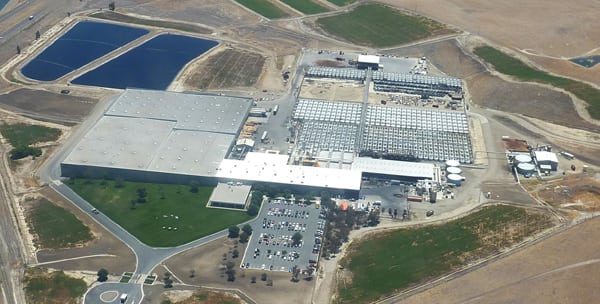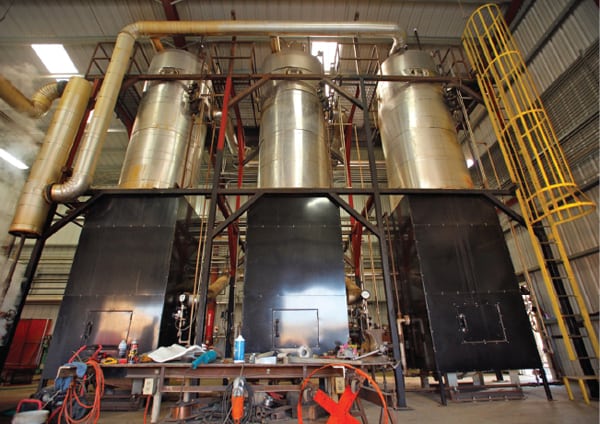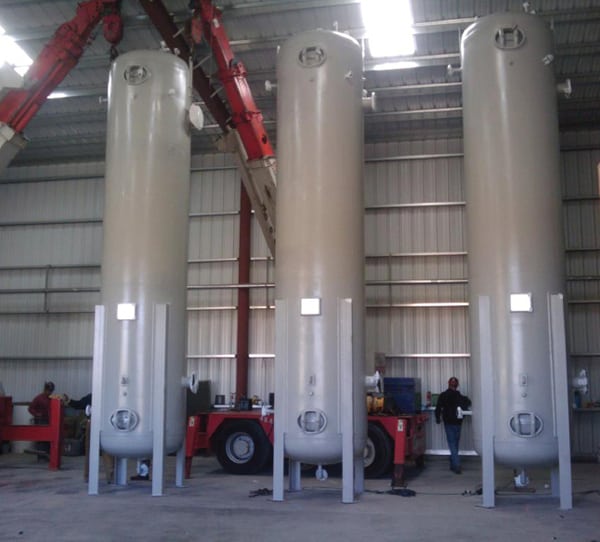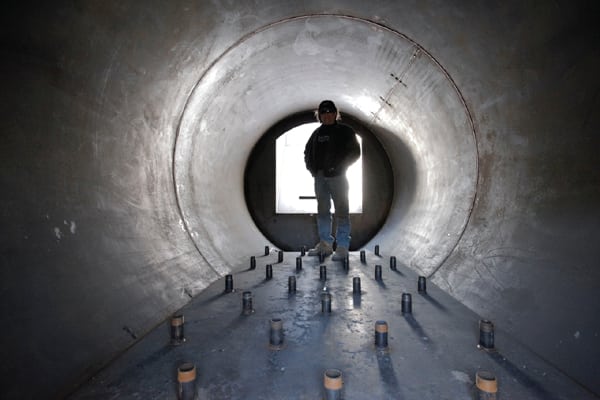Marmaduke Award: Combined Solar Technologies’ Hybrid Plant: Using Wastewater and Olive Pits to Produce Clean Water and Clean Energy
Combined Solar Technologies (CST) has designed, built, owns, and operates a water purification system located at the Musco Family Olive Co. facility in Tracy, Calif., that burns olive pits to purify highly saline wastewater through a distillation process while also producing electric power. For its pioneering approach, CST is the winner of POWER’s 2012 Marmaduke Award for excellence in plant problem-solving. The award is named for Marmaduke Surfaceblow, the fictional marine engineer and plant troubleshooter par excellence, whose exploits were chronicled in POWER beginning in 1948.
 |
| Courtesy: Combined Solar Technologies |
Featured in the Discovery Channel’s recent television special “Powering the Future,” the Combined Solar Technologies’ (CST) innovative water purification system began operating in 2010. The Musco Family Olive Co. hired CST to help its plant—the largest olive-canning facility in the U.S.—better meet the California Water Board’s wastewater treatment standards. The facility’s one-of-a-kind system validated CST’s concept of using biomass fuel combustion for wastewater treatment. The system was designed to generate 375 kWh of electricity and operates year-round.
The Musco facility processes more than 13 billion olives per year, each with a pit that is a source of energy. The combustion system burns about 24 tons of olive pits per day to power its onsite water purification system; no pretreatment is required to utilize the olive pits as fuel (Figure 1). This helps the olive company by both eliminating a waste stream and providing free fuel.
 |
| 1. From pits to power. The CST system, located at the Musco Family Olive Co. facility in Tracy, Calif., uses about 24 tons per day of olive pits to power its onsite water purification system; no pretreatment is required to use the olive pits as fuel. The tanks shown in the background are where Musco stores and cures its olives. Courtesy: Sam Burbank |
The $4 million CST plant has many components of a modern biomass power plant with the major exception of the SteamBoy brine boiler system. Conventional biomass plants consume large amounts of clean water to produce electricity; in contrast, the CST plant produces large amounts of clean water in the process of making electricity. CST designed and built the unique SteamBoy system, which includes a boiler, condenser, and steam engine.
The creative force behind the invention of the SteamBoy system is CST’s Frank “The Rub” Schubert. He is a renaissance man whose career ranges from working on closed water systems for NASA’s man-to-Mars effort to playing music with the famous rock band Devo. Much like the fictional Marmaduke Surfaceblow (see the online reprint of a classic Marmaduke story that will appear with this issue’s story archive), he’s an inventive troubleshooter who’s comfortable using his technical prowess to improvise original solutions to challenging situations.
Wastewater Treatment Technology
“The heart of the CST system is the SteamBoy brine boilers. The design of the boilers allows for the use of wastewater as a feedwater source without the normal fouling that would be associated with standard boilers,” said Robert Schmitt, PE, an engineer with Bibb Engineers, Architects & Constructors who works on a number of CST projects (Figure 2).
 |
| 2. Solving the salt problem. The SteamBoy brine boilers are shown at the Musco Family Olive Co plant. The facility has a zero-liquid discharge system that cleans the highly saline wastewater produced by processing olives and generates electricity at the same time. Courtesy: Sam Burbank |
Victory Energy of Tulsa built the CST SteamBoy brine boilers. All SteamBoy products are inspected and ASME certified.
CST built the steam engine, combustion unit, and condensing unit that are being used at the Musco facility. The plant’s full-scale system features a SteamBoy 1,200 hp steam engine and three SteamBoy steam generators that, on average, operate at a little less than half of rated capacity. Kato Engineering built the 750-kW generator.
The SteamBoy engine, while not as efficient as a modern-day steam turbine, is robust (Figure 3). And unlike a steam turbine, it can handle steam that would typically be considered too harsh to use for power generation. The proprietary EcoPod is CST’s negative pressure evaporation system that uses exhaust from the engine to operate (Figure 4).
 |
| 3. Tough engine. Combined Solar Technologies’ Scott Mattson is shown in front of the SteamBoy 1,200 hp steam engine at the Musco facility. Unlike a steam turbine, it can handle steam that would typically be considered too harsh to use for power generation. Courtesy: Sam Burbank |
 |
| 4. Brine busters. Combined Solar Technologies installed the SteamBoy evaporators at the Musco plant during 2010. In the final process phase, the waste brine is evaporated/concentrated using the steam from the distillation process, making the plant a zero–liquid discharge facility. Courtesy: Sam Burbank |
CST’s technology is an economically viable solution for dealing with wastewater salinity problems. Schmitt said, “the SteamBoy process treats the Musco facility’s highly saline effluent, which can contain upwards of 20,000 ppm of total dissolved solids (TDS), and produces treated water that almost achieves potable water standards.”
The boilers evaporate the water under pressure and produce clean steam (90% to 97%) and a blow-by stream (3% to 10%) that contains some steam and a high concentration of the salts (contaminants). The remaining salts and other contaminants are deposited in the evaporator tubes, from which they are easily removed as dry solids. The resulting distilled water is allowed to leave the top of the boilers as clean pressurized steam that is then directed to electrical generation units before it is condensed back into distilled water.
The distillation process purifies over 90% of the challenging wastewater received from the plant’s olive processing and removes the TDS. The process produces waste brine that is less than 10% of the original wastewater amount. In the final process phase, waste brine is evaporated/concentrated using steam from the distillation process, making the plant a zero–liquid discharge facility. The plant’s top priority is keeping salt out of the environment.
Bob Bibb, chairman and CEO of Bibb Engineers, suggests that CST’s wastewater treatment technology also has many other uses. “Treating wastewater to reduce TDS will soon become big business, particularly within California and regions where frack water is being discharged. CST appears to have one of the few proven treatment systems that works.” Bibb suggests that the CST system may also have future application in power plant zero–liquid discharge systems.
Using Biomass to Generate Electricity
The Musco Plant produces clean water and electricity by processing biomass fuel. The biomass is fed into the combustion unit and hot combustion gas gives up its heat to the oil heat exchanger. The oil heat exchanger delivers the heat transfer oil that is continually circulated though the SteamBoy steam generators. The steam generators, in turn, produce clean, pressurized steam that is directed to the electric generation units that produce electricity. The exhaust steam is directed to drying pans, where its heat is used to dry the remaining solids that are extracted from the brine water.
In addition to purifying water, the plant’s system generates electricity that it uses for miscellaneous internal electrical needs. Schubert said, “the Musco facility has no plans to sell the energy to the grid, as it uses all the electricity that it produces onsite.”
The plant uses a steam piston engine operating at fairly low pressure (200 psig) to produce electrical power. When the plant is scaled up some time in the future, a steam turbine generator configuration will be used to get the highest possible efficiency and reliability possible for power generation.
The Musco plant uses a modern programmable logic control system for monitoring and controlling the various combustion, hot oil, steam, and electrical systems. Schubert said, “this system control philosophy can readily be adapted and up-scaled for future plants.”
CST has trained some of the Musco staff on operations of the facility. In addition, Musco hired some specialized personnel to operate and maintain the plant.
Successful Air Emissions Control
When CST installed the new wastewater purification system at the plant, Musco made a significant investment in state-of-the-art emissions controls. The system uses the CST Vector Jet combustion system, which burns the olive pits as fuel, as well as a Donaldson Torit baghouse, and a Babcock Power selective catalytic reduction unit (Figures 5 and 6).
 |
| 5. Under construction. A worker is shown inside the shell of the CST Vector Jet combustion system before the refractory bricks and vector nozzles were added. The system burns olive pits, a former waste product, as fuel. Courtesy: Sam Burbank |
 |
| 6. Ultra-clean firing. The Combined Solar Technologies plant’s combustion and emission system is shown next to the silo and auger feed system. Recent source testing of the system showed that its emissions are the lowest of any biomass-fired system in California. Courtesy: Olga Perry |
The CST biomass burner system is ultra-clean firing. The combustion stack is monitored for emissions and is capable of meeting the California Air Quality Standards. Recent source testing of the CST system located at the Musco facility showed that emissions from the CST system are the lowest of any biomass-fired facility in California (approximately 4 ppm of nitrogen oxides), according to Schmitt.
The air quality permit was the first permit the plant had to obtain. CST and Musco’s environmental engineer worked together to submit a permit application to the California Air Quality Board, and the permitting process took approximately three and a half months. A water quality discharge permit was not needed, as the Musco facility already had one. The plant did not need any federal permits.
Innovative Design with Versatile Applications
Schubert said the important technological innovations at the Musco plant are the CST SteamBoy brine boilers, the Vector jet biomass combustion system, the modern steam engine, and the Ecopod with its drying pan technology.
The CST plant’s olive pit–powered renewable energy and wastewater system is also known as RENEWS. In July 2011, the CST RENEWS system was lauded at the inaugural Agricultural Innovation conference at University of California, Davis, where the plant received a “Game Changer of the Year” award in the Innovation in Energy and Agriculture category for its unique water purification system that solved its high-saline discharge problem.
“In addition to the olive processing industry, a number of other types of food processors have combustible waste that can be used to power the CST SteamBoy system,” Schubert said. “Examples are the wine industry, the dairy industry, the cheese industry, and the tomato-canning industry.”
With the successful demonstration of the SteamBoy system at the Musco plant, CST is now able to expand the use of its technology to a number of new venues. For example, the city of Tracy, Calif., recently hired CST to improve its municipal wastewater treatment plant’s (WWTP) operations. The company has already installed its SteamBoy Jr. unit in the plant and it is currently reducing salts from the plant’s discharge stream by over 97%. CST also has begun the design of a full-scale system that will include such green heat sources as the biogas currently coming from the plant’s digester, a CST bioreactor for woody materials, and a solar thermal array.
In addition, CST is in the design phase for biomass plants for the Eastern Municipal Water District east of Los Angeles; frack water processing facilities in Pennsylvania and California; a municipal WWTP similar to the Tracy project for the city of Salinas, Calif.; and the conversion of an existing biomass facility to SteamBoy technology in New York.
— Angela Neville, JD, is senior editor of POWER.